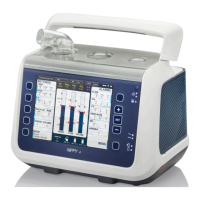
Do you have a question about the Breas Nippy 4 and is the answer not in the manual?
| Type | Portable Ventilator |
|---|---|
| Display | LCD screen |
| Modes | CPAP, S, T, ST |
| Weight | 4.0 kg |
| Battery life | Up to 8 hours |
| Pressure range | 4-25 cmH2O |
| Tidal Volume Range | 50 – 2000 ml |
| Respiratory Rate | 4 – 40 breaths per minute |
| Power Supply | 100 – 240 V AC, 50/60 Hz |
| Alarms | High pressure, Low pressure, Power failure |
| Battery Backup | Internal and external battery options |
Defines the Nippy 4 ventilator and its ventilation modes.
Specifies the intended applications and patient population for the Nippy 4.
Lists conditions where the Nippy 4 should not be used.
Details the environments where the Nippy 4 is designed for use.
Describes the qualifications and roles of different user types.
Details requirements and training for healthcare professionals.
Outlines responsibilities and training for non-professional users.
Specifies requirements for equipment maintenance and repair.
Provides guidance on using the manual and its icons.
Identifies the intended readers for different sections of the manual.
Explains the meaning of various icons used in the manual.
Provides contact and address details for the manufacturer.
Essential safety guidelines for operating the ventilator.
Precautions related to electrical hazards and connections.
Guidelines for safe operation regarding temperature and atmosphere.
Safety considerations for connecting and using the patient circuit.
Instructions and warnings regarding the use of air filters.
Safety aspects related to humidification and accessories.
Safety warnings and procedures for cleaning and maintenance.
Safety guidelines when using oxygen with the ventilator.
Lists and describes the primary components of the Nippy 4.
Identifies and explains the controls and indicators on the front panel.
Details components located on the side panels of the ventilator.
Step-by-step guide for removing and fitting side panels.
Explains symbols and labels on the equipment.
Clarifies various symbols found on the device and packaging.
Procedures to verify components and condition before initial operation.
Guidelines for positioning the ventilator safely and effectively.
Steps for connecting the ventilator to the power supply.
Instructions for attaching the patient circuit to the device.
Comprehensive checks before starting the ventilator.
Guidance on setting up patient-specific therapy parameters.
Procedure for conducting the mandatory pre-use test.
Procedures for powering the ventilator on and off.
Steps to power up the device and enter standby.
How to initiate and manage the pressure ramp feature.
Instructions for stopping an active pressure ramp.
Procedure to safely end a therapy session.
Steps to power down or put the device into sleep mode.
Explains how to move through menus and screens.
Defines icons displayed on the ventilator screen.
General layout of the ventilator display in different modes.
Information on using pre-configured settings profiles.
Details on adjusting ventilation parameters.
General procedure for modifying any setting.
Comprehensive list of adjustable ventilation parameters.
Overview of available alarm settings and priorities.
Explanation of displayed real-time treatment data.
How to access and navigate the device's menu system.
Adjusting humidifier and heated circuit parameters.
Configuring settings for periodic extended breaths.
Options for enabling or starting the pre-use test.
Customizing display and device behavior.
Viewing usage statistics and treatment adherence.
Accessing records of alarms and system events.
Methods for exporting patient data.
Information on battery management and operation.
Order of preference for power sources.
Guidelines for charging internal and click-in batteries.
Explains the symbols indicating battery status.
Function and use of the built-in battery.
Details on the removable click-in battery.
Factors affecting battery life.
Recommendations for long-term battery storage.
Connecting and using external DC power sources.
General instructions for connecting accessories.
Procedures for handling various cables.
Connecting to a nurse call system.
Information on using the FiO2 sensor for monitoring.
Information on the remote alarm system.
How to use the SpO2 module for monitoring.
Connecting and using the remote start/stop function.
How to use and the functions of the protective cover.
Attaching and using the ventilator with a trolley.
Instructions for using the click-in humidifier.
Connecting and activating the heated wire circuit.
Overview of how alarms are managed and indicated.
Recommended positioning for receiving alarm notifications.
Alarms related to patient physiological parameters.
Alarms related to device functions and errors.
Procedures for testing alarm functionality.
Procedures for cleaning the main unit and its parts.
Instructions for filter maintenance.
Procedures for preparing the ventilator for a new patient.
Schedule and requirements for routine maintenance.
Guidelines for authorized service and repair.
Recommendations for storing the ventilator.
Procedures for environmentally sound disposal of the device.
Overview of the ventilator system configuration.
Information on data logging and specifications.
Information on electromagnetic compatibility.
Default modes, functions, and alarm settings.
Lists approved patient circuits and their functions.
Details available power supply and battery accessories.
Lists accessories for patient monitoring and data transfer.
Information on replacement filters and detachable components.
Lists additional accessories like trolleys and clamps.
A form for recording patient-specific ventilation settings.
Statement regarding compliance with FAA regulations for aircraft use.
